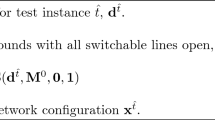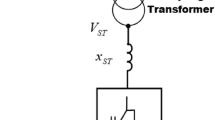Abstract
This paper proposes the incorporation of a DC line and loop system into the power flow study of a distribution system. A Modified Backward Forward Sweep (BFS) algorithm based on the sequential method is utilized to solve the power flow problem in a power system containing loop caused by either a DC line or a sectionalizing switch. It solves the power flow problem by treating the DC line or sectionalizing switch as two unconnected nodes, thus changing the system into a radial one. Their equivalent parameters are then found at the distribution system’s point of common coupling (PCC) and are used in the radial power flow calculation. BFS is employed to calculate the power flow solution after the system becomes radial. Finally, convergence is achieved when the voltage difference at the PCC calculated from the current and previous iterations is below the tolerance level. Test cases are presented to verify the proposed algorithm, and results show that the proposed algorithm achieves an identical result to the reference values.









Similar content being viewed by others
References
Srinivas (2000) Distribution load flows: a brief review. 2000 IEEE Power Eng Soc Conf Proc 2:942–945
Kersting WH (2017) Distribution system modeling and analysis, 4th edn. CRC Press, Boca Raton
Bazrafshan M, Gatsis N (2018) Comprehensive modeling of three-phase distribution systems via the bus admittance matrix. IEEE Trans Power Syst 33(2):2015–2029
Tbaileh A, Jain H, Broadwater R, Cordova J, Arghandeh R, Dilek M (2017) Graph trace analysis: an object-oriented power flow, verifications and comparisons. Electr Power Syst Res 147:145–153
Kersting WH (2015) The simulation of loop flow in radial distribution analysis programs. IEEE Trans Ind Appl 51(2):1928–1932
Khushalani S, Schulz N (2006) Unbalanced distribution power flow with distributed generation. In: Proceedings of 2005/2006 IEEE/PES transmission and distribution conference and exhibition. IEEE, Dallas, Texas, pp 301–306
Cheng D, Önen A, Arghandeh R, Jung J, Broadwater R, Scirbona C (2014) Model centric approach for monte carlo assessment of storm restoration and smart grid automation. In: Proceedings of the ASME 2014 power conference. ASME, Baltimore, Maryland, pp 1–4
Dilek M, De León F, Broadwater R, Lee S (2010) A robust multiphase power flow for general distribution networks. IEEE Trans Power Syst 25(2):760–768
Wang Y, Xu Q, Liu M, Zheng J (2018) A novel system operation mode with flexible bus type selection method in DC power systems. Int J Electr Power Energy Syst 103:1–11
Wang W, Barnes M (2014) Power flow algorithms for multi-terminal VSC-HVDC with droop control. IEEE Trans Power Syst 29(4):1721–1730
Khan S, Bhowmick S (2018) A comprehensive power-flow model of multi-terminal PWM based VSC-HVDC systems with DC voltage droop control. Int J Electr Power Energy Syst 102:71–83
Kumbhare JM, Renge MM (2014) Line commutated converter for grid interfacing of solar photovoltaic array. In: Proceedings of 2014 IEEE international conference power electronics drives energy system. IEEE, Mumbai, India
Ahmed HMA, Eltantawy AB, Salama MMA (2018) A generalized approach to the load flow analysis of AC–DC hybrid distribution systems. IEEE Trans Power Syst 33(2):2117–2127
Stott B, Jardim J, Alsac O (2009) DC power flow revisited. IEEE Trans Power Syst 24(3):1290–1300
Mousavizadeh S (2013) Load flow calculations in AC/DC distribution network including weakly mesh, distributed generation and energy storage units. In: Proceedings of 22nd international conference on electricity distribution. IEEE, Stockholm, Sweden, pp 10–13
Eremia M (2016) Advanced solutions in power systems: HVDC, FACTS, and artificial intelligence. Wiley, Hoboken
Kundur P, Balu NJ, Lauby MG (1994) Power system stability and control. McGraw-Hill, New York
Acknowledgements
This research was supported by the Ministry of Trade, Industry & Energy (MOTIE), Korea Institute for Advancement of Technology (KIAT) through the Encouragement Program for The Industries of Economic Cooperation Region (No. P0006091).
Author information
Authors and Affiliations
Corresponding author
Additional information
Publisher's Note
Springer Nature remains neutral with regard to jurisdictional claims in published maps and institutional affiliations.
Appendix
Appendix
1.1 A. Power Flow Comparisons for the Looped System
See Table 4.
1.2 B. DC Line Model in Simulink
The parameters for the DC line model in the Simulink are as follow (Fig. 10):
-
1.
Three-phase pi-section line parameters;
-
Positive-sequence resistance: 0.835 Ω/km.
-
Zero-sequence resistance: 4.720 Ω/km.
-
Positive-sequence inductance: 1.078 × 10−3 H/km.
-
Zero-sequence inductance: 3.1715 × 10−3 H/km.
-
Positive-sequence capacitor: 12.74 × 10−14 F/km.
-
Zero-sequence capacitor: 10−20 F/km.
-
-
2.
Parallel RLC branch parameters:
-
Resistance: 26.07 Ω.
-
Inductance: 48.86 × 10−3 H.
-
-
3.
DC line pi-line parameter:
-
Resistance: 1.185 Ω/km.
-
Inductance: 0.9337 × 10−3 H/km.
-
Capacitance: 12.74 × 10−9 F/k.
-
1.3 C. Power Flow Comparisons of the Modified IEEE 13 Node System
See Table 5.
Rights and permissions
About this article
Cite this article
Widiputra, V., Yun, S. & Jung, J. Looped Distribution System Radialization Algorithm for Power Flow Analysis Including DC Line and Sectionalizing Switch. J. Electr. Eng. Technol. 14, 1893–1905 (2019). https://doi.org/10.1007/s42835-019-00238-2
Received:
Revised:
Accepted:
Published:
Issue Date:
DOI: https://doi.org/10.1007/s42835-019-00238-2





